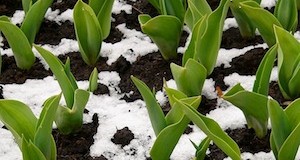|
Listen To The Article
|
 Making vinegar is an age-old practice. Once you have had success making vinegar from the very basics around your home or homestead, the world of vinegar making gets easier and broadens. Having a batch of vinegar already made simplifies the process of making vinegar in the future, since you have both the vinegar itself and (hopefully) the mother to hasten the process. When you have good vinegar to begin with, you have an excellent source of acetic bacteria to jumpstart the making of new vinegars and greatly decrease the likelihood of bad bacteria contaminating the batch.
Making vinegar is an age-old practice. Once you have had success making vinegar from the very basics around your home or homestead, the world of vinegar making gets easier and broadens. Having a batch of vinegar already made simplifies the process of making vinegar in the future, since you have both the vinegar itself and (hopefully) the mother to hasten the process. When you have good vinegar to begin with, you have an excellent source of acetic bacteria to jumpstart the making of new vinegars and greatly decrease the likelihood of bad bacteria contaminating the batch.
Since you are working with living organisms, it is important to use only live batches and mothers for the propagation of more vinegar. Don’t use anything that has been pasteurized or otherwise treated in a way that will have killed off your good bacteria, as that would defeat the purpose of using it to make more vinegar. Also, keep in mind that cleanliness is important even when you are adding a good dose of “good” bacteria to your batches. You don’t want to give “bad” bacteria the upper hand!
Here are some other ways to make vinegars using your homemade vinegar, mothers, and other not-so-basic items you might find in your home.
Apple Cider Vinegar
Since apple cider vinegar tends to be the most common of vinegars to start with, it would make sense to know how to make more of it once you have had a successful batch. To make apple cider vinegar using your existing vinegar, you will follow steps very similar to making vinegar from scratch, only you will be adding some of your vinegar and/or mother. Here’s how it works.
Stage 1: Making Alcohol
This stage will remain the same whether you choose to use apple scraps or apple cider. Once you have your alcohol made and it stops bubbling (a sign it is finished with this stage), you will be ready for the next stage.
Stage 2: On to the Vinegar
This is the stage where you allow the hard cider/alcohol to be exposed to air to allow the acetic acid to grow and make your vinegar.
If you have begun with apple scraps, strain them to retrieve the alcohol. If you began with cider, you may want to strain any sediment from the hard cider.
Divide your alcohol between containers (glass gallon jugs or jars work well) to increase surface exposure to air. Then, add some of your existing vinegar to the batch. A rough estimate of how much to use is approximately one cup unpasteurized vinegar per quart of hard cider/alcohol. Adding some of the mother from a previous batch will also hasten the vinegar-making process. Cover the containers with cheesecloth and allow them to sit in a warm place until the batch is strong enough to use (usually a week or two). Strain the vinegar, then bottle or jar the vinegar for storage. Do not use metal containers to store your vinegar.
Find 150 Super-Easy Herbal Formulas for Green Cleaning
Making Vinegar Using Beech Shavings
In the past, one of the ways that have been developed to make vinegar fairly quickly is to use beech shavings (or the shavings of another very resinous tree).
You will need:
- A wooden barrel with a cock at the bottom for drawing the vinegar out once finished
- Beech (or other) shavings—enough to mostly fill the barrel
- A wooden plate perforated with pinhole-sized holes to fit snugly inside the barrel
- Vinegar (the type you are trying to make)
- Alcohol (wine, beer, or hard cider—depending on what you are trying to make)
1. Fill your clean barrel with the beech (or other) shavings.
2. Soak your shavings with the vinegar of your choice.
3. Place the wooden plate over the wood shavings and snugly against the sides of the barrel.
4. Slowly pour your alcohol of choice over the plate. It will slowly seep through the pinholes, maximizing oxygen exposure, and into the vinegar-soaked shavings where it will get good exposure to the acetic bacteria and begin making vinegar.
5. Allow this to sit for about a week. You should have a finished vinegar by that time.
6. Dispense your vinegar through the cock attached to the barrel. Bottle or jar it for storage.
Wine Vinegar
While merely leaving a partial bottle of wine open on the counter for a few weeks may produce wine vinegar, you may want to make more at a time. To make wine vinegar, you will need to start with a homemade wine or a wine made without preservatives (these tend to be found at health food stores).
In addition, you will need:
- Gallon glass jar
- About one quart of homemade/no preservative wine
- About one cup of wine vinegar (again, no preservatives)
1. Pour the wine and vinegar into the glass jar and cover with cheesecloth or something similar.
2. Allow the mixture to sit at room temperature for a few weeks. During this time, a mother should form at the top of the liquid and then settle to the bottom. This is the sign that your wine vinegar is finished.
3. Bottle and cork or cover with another type of non-metal lid. Alternatively, you may remove the vinegar from the jug as you have need of it and replace what you remove with more wine, keeping the batch in a perpetual vinegar-making mode.
Malt Vinegar
Malt vinegar is made using a grain (usually barley or oats) that has been sprouted, converting the starch of the grain to sugar (maltose), then to alcohol (beer), and then to vinegar. You can take a shortcut and start with a can or two of beer.
You will need:
- Container (non-metal)
- Beer
- Unpasteurized apple cider vinegar (with the mother), equal to about one-fourth of the amount of beer you have (more or less according to your preference and availability)
1. Pour your beer into the container and allow it to sit open for one day to evaporate any sulphite preservatives (if it has any).
2. Add the unpasteurized apple cider vinegar and any mother that happens to pour into the container.
3. Cover the container loosely to allow air in and out. Sit it somewhere that is at room temperature and out of direct sunlight.
4. The mother should form at the top of the mixture and start to working on making vinegar within a matter of days. Allow the mother to work until it settles to the bottom of the container. This will take about a week—it varies with the alcohol content of your beer. Test a bit from time to time, being careful you are not testing the mother (which will not taste good) to see if it is strong enough for you. If it is not strong enough yet, allow it to sit longer.
5. Once the malt vinegar is finished, strain and bottle it in an airtight container. It is fine to use as is, but you may want to let it sit for a few months to achieve a mellower flavor.
Herbal Vinegars
Herbal vinegars are easily made, particularly if you have fresh herbs on hand. To make them, simply cut sprigs of desired herbs and drop into your finished vinegar. I would recommend flavoring a small amount of vinegar to begin with, to see what herbs you prefer and in what quantities, and work from there. Some suggested herbs are tarragon, basil, and oregano, but the options and combinations are really as vast as your available herbs and their combinations.
Kombucha: An Alternative Vinegar Source
Kombucha is a fermented drink that has been around for some time. It can be left to ferment past the first stage to turn into alcohol and then into vinegar. This vinegar is less acidic than, say, apple cider vinegar. If you have ever left a batch of kombucha fermenting longer than you’d planned, you very well may have been inadvertently making kombucha vinegar. You might consider using this vinegar for some of your vinegar needs.
Make “Off-The-Grid” Super Foods Secretly In Your Home
How To Make Kombucha
To make one gallon of kombucha, you will need:
- 1 Kombucha “scoby” (symbiotic culture of bacteria and yeast)—ask around or purchase one online
- Gallon glass container
- Plastic or wooden spoon for stirring (never metal)
- Cheesecloth or similar for covering
- Rubber band or string or similar to tie on cloth
- About thirteen cups water
- Eight black tea bags or two tablespoons of loose tea
- One cup sugar
- Two cups or so of Kombucha tea from a previous batch (you may also use raw unfiltered apple cider vinegar)
1. Wash everything thoroughly before you begin.
2. Bring your water and sugar to boil, add the tea bags or loose tea, and allow it to steep ten minutes. Allow the mixture to cool to room temperature. I have hastened this process before by boiling half of the water and steeping the tea, then mixing the hot tea with the rest of the cool water. The point of cooling the tea/water is so that you do not kill your scoby.
3. Pour the tea and sugar mixture into your gallon glass jar. Pour in your kombucha tea or apple cider vinegar and stir. Then dump in your scoby.
4. Cover the jar with the cloth and tie it on to keep out any flies, ants, etc.
5. Set the jar somewhere that is at room temperature, out of direct sunlight and away from anything else that is fermenting, and allow it to ferment five days to a week. During this time, a new scoby should have formed at the top of your liquid. If so, this is a good thing! Save it in a jar with some reserved kombucha in your refrigerator to have on hand for your next batch.
6. If you are making kombucha to drink, you may strain the kombucha into a glass container and refrigerate it to slow the fermentation process. If you are looking to make vinegar, simply allow the kombucha to ferment further. Prolonged over-fermentation of kombucha can kill the scoby, so you will want to keep spare scobies on hand. Once you are in the kombucha-making business, you will find that this will not be a problem and will likely have plenty to spare.
7. Once you have let your kombucha brew until it reaches a vinegary taste (yes, you need to taste it), you can strain your kombucha vinegar, bottle it, and use it as you wish.
Note: If anything looks or smells “off” in any of your vinegar mothers or in your scoby—such as off-color moldy spots or the like—toss the batch, sterilize your tools and vessels, and start over. Don’t risk your health.
These are just a few ways of making vinegar from your original batches and methods. You will discover that the more you experiment with fermentation, the more options you will have. What kinds of vinegars have you made? Do you have any particularly delicious or creative ways of flavoring vinegar that have worked well for you? Please share!
©2013 Off the Grid News
 Off The Grid News Better Ideas For Off The Grid Living
Off The Grid News Better Ideas For Off The Grid Living




